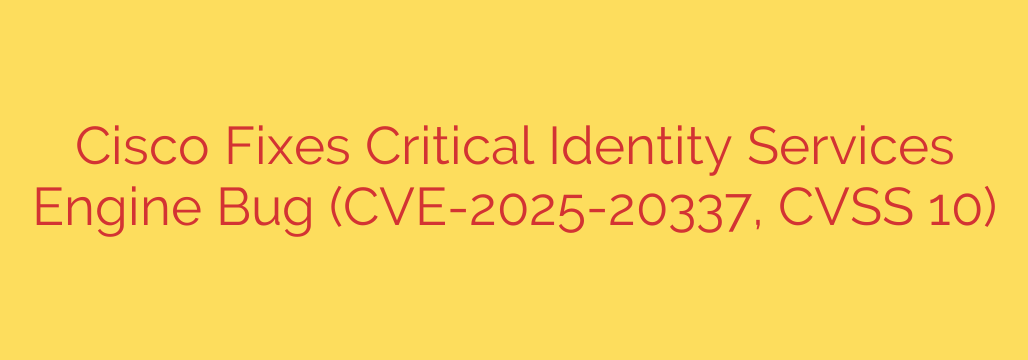
Critical Cisco ISE Flaw (CVE-2025-20337) Allows Full System Takeover: Patch Immediately
A critical security vulnerability has been identified in Cisco’s Identity Services Engine (ISE), a widely used network administration and access control solution. The flaw, tracked as CVE-2025-20337, has received the maximum possible severity score of CVSS 10.0, signaling an extreme risk to unpatched systems.
This vulnerability allows a remote, unauthenticated attacker to bypass security checks and gain complete control over an affected device with root-level privileges. Administrators are urged to apply the necessary security patches without delay to prevent potential exploitation.
Understanding the CVE-2025-20337 Vulnerability
The vulnerability exists within the web-based management interface of Cisco ISE. Specifically, an error in how the system processes certain API requests allows an attacker to send a specially crafted message that bypasses authentication entirely.
By successfully exploiting this flaw, an attacker can execute arbitrary commands on the underlying operating system as the root user. This level of access is equivalent to having complete administrative control over the system, making it one of the most severe types of security flaws.
The Severe Impact: Why This is a CVSS 10.0 Threat
The perfect CVSS score of 10.0 is reserved for vulnerabilities that are easy to exploit and have a catastrophic impact. CVE-2025-20337 meets this criteria for several reasons:
- No Authentication Required: An attacker does not need any username, password, or prior access to the network to launch an attack.
- Remote Exploitation: The attack can be carried out over a network, meaning the threat actor can be anywhere in the world.
- Complete System Control: Achieving root-level access allows an attacker to view, modify, or delete any data; install persistent malware or ransomware; disable network services; or use the compromised device as a pivot point to attack other systems on the internal network.
In essence, a successful exploit gives an attacker the keys to your network’s kingdom, as Cisco ISE is often the central gatekeeper for network access control.
Which Cisco ISE Versions Are Affected?
It is crucial for network administrators to identify whether their deployments are at risk. The vulnerability affects the following Cisco ISE releases:
- Cisco ISE, Release 3.1
- Cisco ISE, Release 3.2
- Cisco ISE, Release 3.3
Devices running Cisco ISE Release 3.4 and later are not affected by this specific vulnerability.
Immediate Action Required: How to Secure Your Network
Cisco has released software updates to address this critical flaw, and prompt patching is the only effective mitigation strategy.
1. Patch Immediately: There are no workarounds that can resolve this vulnerability. Administrators must install the patched software versions provided by Cisco to secure their systems.
2. Prioritize External-Facing Devices: Any Cisco ISE management interface exposed to the public internet is at an exceptionally high risk and should be patched with the highest priority. Best security practices dictate that management interfaces should never be exposed to the internet. If they are, restrict access immediately to trusted IP addresses while you prepare to patch.
3. Review Access Logs: Investigate system logs for any unusual or unauthorized API requests to the management interface. While there is currently no evidence of this vulnerability being actively exploited in the wild, this can change rapidly. Proactive monitoring can help detect potential signs of compromise.
This vulnerability was discovered by Cisco during internal security testing, highlighting the importance of continuous, proactive security assessments. For network administrators, it serves as a critical reminder that maintaining a robust and timely patch management program is essential for protecting critical infrastructure from ever-evolving cyber threats.
Source: https://securityaffairs.com/180044/security/cisco-patches-critical-cve-2025-20337-bug-in-identity-services-engine-with-cvss-10-severity.html








